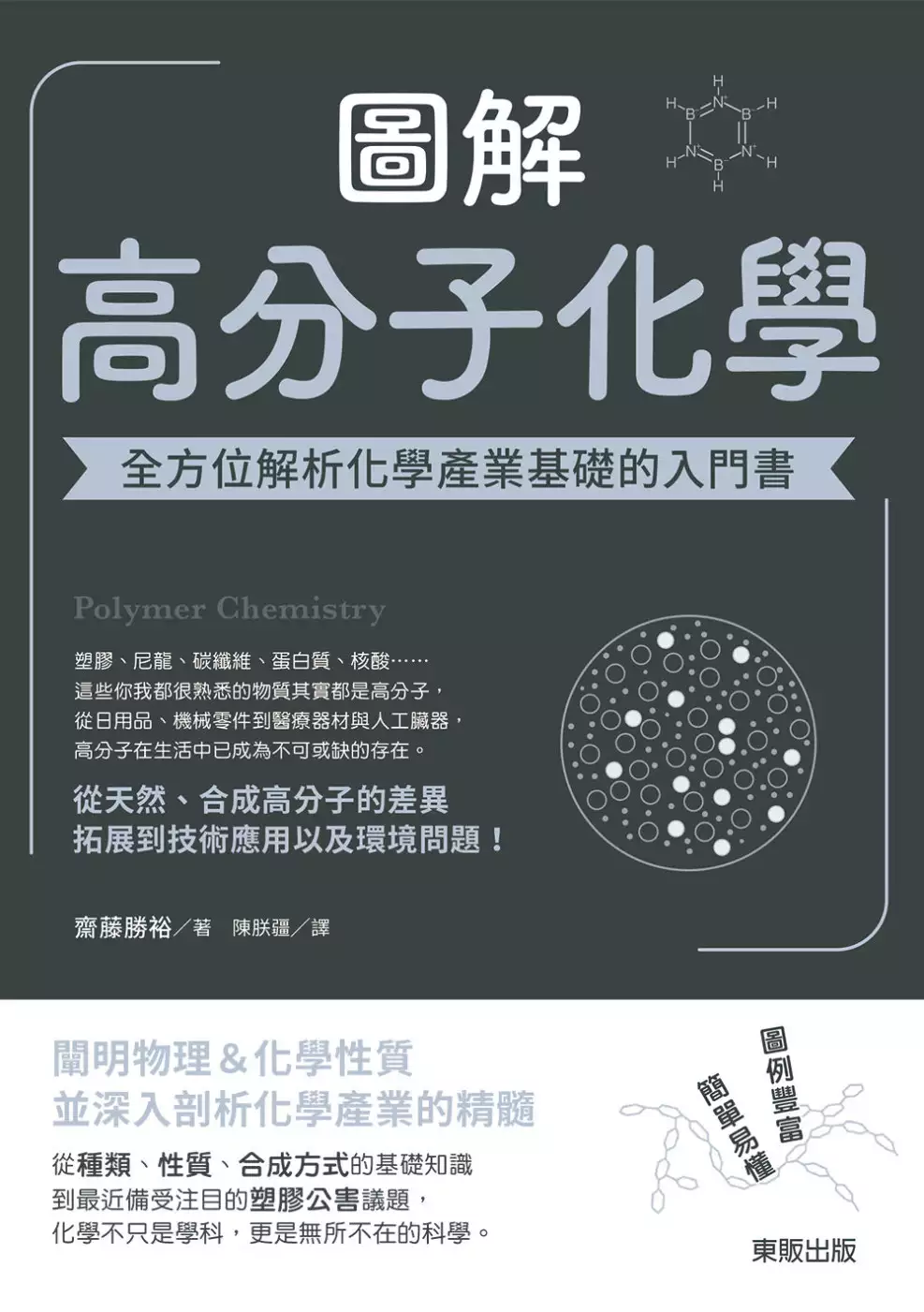催化劑性質的問題,我們搜遍了碩博士論文和台灣出版的書籍,推薦齋藤勝裕寫的 圖解高分子化學:全方位解析化學產業基礎的入門書 和湯惠光,蔡永昌的 新一代 科大四技化工群普通化學與實習升學寶典 - 最新版(第二版) - 附MOSME行動學習一點通:詳解.診斷.評量都 可以從中找到所需的評價。
這兩本書分別來自台灣東販 和台科大所出版 。
國立臺北科技大學 能源與光電材料外國學生專班(EOMP) 陳生明所指導 NANDINI NATARAJ的 闡明鑭系元素硫屬化合物整合沸石咪唑架構作為電化學感測器和水分解應用雙功能的電催化劑性質 (2021),提出催化劑性質關鍵因素是什麼,來自於二維材料、金屬有機框架、稀土金屬硒化物、電化學感測、水分解反應。
而第二篇論文東吳大學 化學系 王榮輝所指導 鄭哲珉的 探討一鍋法合成之Ni0.2Mn0.8O催化劑對甲醇蒸氣重組過程中氧化銅的附載活性影響 (2021),提出因為有 催化劑、甲醇蒸氣重組的重點而找出了 催化劑性質的解答。
圖解高分子化學:全方位解析化學產業基礎的入門書

為了解決催化劑性質 的問題,作者齋藤勝裕 這樣論述:
一書剖析現代社會不可或缺的化學產業知識 以不同形式活躍於生活當中的科學結晶 活用於建築、日用品以至於醫療領域的高分子全貌 高分子不是只有塑膠。橡膠、合成纖維也是高分子。 我們周遭的多種物質,譬如保麗龍、合成纖維中的聚酯與尼龍、 由橡膠製成的橡皮筋與輪胎,都是高分子。 植物由纖維素、澱粉等組成。這些纖維素、澱粉都屬於高分子。 動物的身體由蛋白質組成,蛋白質也是高分子。 不僅如此,負責遺傳功能的DNA或RNA等核酸,也是典型的高分子。 也就是說,高分子不只包含了由堅硬塑膠製成的櫥櫃、富彈性的橡膠製品, 也包含了各種維持生命、傳承生命的分子。 甚至連隱形眼
鏡、假牙,甚至是人造血管,都是高分子。 到了現代,不僅眼前的世界到處都是高分子,高分子也開始進入了我們的身體「內部」。 人類以化學方式製造出來高分子,稱做合成高分子。 最早的合成高分子「聚乙烯」於19世紀發明。 在這之後,1930年的美國化學家,華萊士.卡羅瑟斯發明了尼龍66後, 各種高分子化合物陸續被合成、開發出來,形成今日的盛況。 但於此同時,高分子也產生了許多過去未曾出現的問題, 其中最讓人頭痛的就是廢棄問題──塑膠公害。 堅固耐用是高分子的一大優點,它們耐熱、耐光、耐化學藥劑。 但這也表示它們遭丟棄後,難以自然分解。 在我們看不到的地方,有許
多遭丟棄塑膠製品仍保持著原本的樣子。 海洋中也漂流著許多細碎的塑膠微粒。 原本以「合成」為主軸的高分子化學,在新時代中可能還需考慮「分解」階段。 本書即是將高分子化學的基礎知識,以簡單明瞭的方式解說。 書中也會提及天然高分子和合成高分子的種類、性質和差異, 高分子所面臨的環境問題的解決方案,以及與SDGs相關的主題。
闡明鑭系元素硫屬化合物整合沸石咪唑架構作為電化學感測器和水分解應用雙功能的電催化劑性質
為了解決催化劑性質 的問題,作者NANDINI NATARAJ 這樣論述:
摘要 iABSTRACT vAcknowledgements ixTable of Contents xivList of Tables xxList of Figures xxiList of Scheme xxviiChapter 1 Introduction xxvii1.1 Nanoscience and nanotechnology 11.2 Nanomaterials 21.2.1 Classifications of nanomaterials 21.3 Dimensional classification 31.3.1 Zero dimensional 41.3.2 One
dimension 41.3.3 Two dimensions 41.3.4 Three dimensions 51.4 Significance of materials at the nanoscale 51.5 Synthesis of nanomaterials 51.5.1 Top-down approach 61.5.2 Bottom-up approach 71.5.3 Co-precipitation method 81.5.4 Hydrothermal method 91.5.5 Sol-Gel method 101.6 Metal chalcogenides 111.6.1
Rare earth metal selenides 121.7 Metal-organic framework 131.7.1 Synthesis and synthesis types of ZIF-8 151.7.2 Composites with ZIF-8 161.7.3 Selenides with ZIF-8 171.8 Electrochemical sensors 171.9 Biological compounds 191.9.1 Adenine 201.9.2 Guanine 211.9.3 Serotonin 221.10 Water Electrolysis 231
.10.1 Hydrogen evolution reaction 261.10.2 Oxygen evolution reaction 271.10.3 Important parameter analysis in water splitting 281.10.4 Substrates for water splitting 301.11 Motivation of the work 311.12 Aim and objectives of research work 321.13 Organization of thesis 33Chapter 2 Experimental proced
ure and Characterization techniques 362.1 Chemicals 362.2 Experimental procedures 362.2.1 Synthesis of PrSe 362.2.2 Synthesis of ZIF and Pr@ZIF 372.2.3 Synthesis of PrSe/Pr@ZIF composite 372.2.4 Preparation of SmSe 382.2.5 Preparation of ZIF and Sm@ZIF 382.2.6 Preparation of SmSe/Sm@ZIF composite 39
2.2.7 The synthesis procedure of EuSe 402.2.8 The synthesis procedure of ZIF and Eu@ZIF 402.2.9 The synthesis procedure of EuSe/Eu@ZIF 412.3 Fabrication of different modified electrodes 422.4 Fabrication of different materials over carbon cloth 432.5 Characterization techniques 432.5.1 Introduction
432.5.2 X-ray Diffraction (XRD) 442.5.3 X-ray photoelectron spectroscopy 462.5.4 Electron microscope 472.5.5 Field Emission Scanning Electron Microscope 482.5.6 EDAX 492.5.7 High Resolution Transmission Electron Microscope 502.5.8 Fourier Transform Infra-Red spectroscopy 512.5.9 Brunauer Emmett Tell
er 522.6 Electrochemical characterization 532.6.1 Cyclic voltammetry 542.6.2 Differential pulse voltammetry 552.6.3 Linear sweep voltammetry 562.6.4 Chronoamperometry 562.6.5 Chronopotentiometry 572.6.6 Electrochemical Impedance Spectroscopy (EIS) 572.6.7 Electrochemical workstation 58Chapter 3 Self
-assembled praseodymium selenide entrapped metal organic frame work as a bifunctional electrocatalyst for electrochemical detection and oxygen evolution reaction 593.1 Graphical abstract of dual functional MOF/RES electro-catalyst 593.2 Highlights 603.3 Introduction 603.4 Chemical, synthesis and cha
racterization techniques 633.5 Results and discussion 633.5.1 Structural analysis 633.5.2 Morphological analysis 673.5.3 Surface area analysis 723.6 Electrochemical analysis 723.6.1 Optimization of PrSe/Pr@ZIF 723.6.2 Electrochemical resistance analysis 733.6.3 Electrochemical redox peak analysis 73
3.6.4 Electrochemical detection of guanine 753.6.5 Optimization of electrolyte 783.6.6 Differential pulse voltammetry detection of GN 793.6.7 Selectivity analysis at PrSe/Pr@ZIF/GCE 813.6.8 Repeatability, reproducibility and stability analysis 833.6.9 Real sample analysis at PrSe/Pr@ZIF/GCE 853.7 El
ectrochemical oxygen evolution reaction (OER) for different electrodes 863.8 Conclusion 93Chapter 4 Engineering the nanostructured samarium selenide encapsulated zeolitic imidazole framework as an efficient dual-functional electrocatalyst for the electrochemical sensing and oxygen evolution reaction
954.1 Graphical abstract of SmSe/Sm@ZIF electrode for dual application 954.2 Highlights 964.3 Introduction 964.4 Chemicals, synthesis and characterization techniques 1004.5 Results and discussion 1004.5.1 Structural analysis 1004.5.2 BET analysis 1044.5.3 Morphological analysis 1044.6 Electrochemic
al analysis 1094.6.1 Optimization of SmSe/Sm@ZIF 1094.6.2 Electrochemical impedance spectroscopy 1104.6.3 Surface area analysis of the differently modified electrodes 1114.6.4 Electrochemical oxidation of SRN at various fabricated electrode 1134.6.5 Electrochemical parameter analysis at SmSe/Sm@ZIF/
GCE with SRN 1144.6.6 Precise electrochemical detection of SRN at CS/C@ZF/GCE 1174.6.7 Anti-interference study at SmSe/Sm@ZIF/GCE 1194.6.8 Capability tests of the SmSe/Sm@ZIF fabricated electrode for SRN sensing 1214.6.9 Real sample analysis in biological samples 1234.7 Water splitting application 1
244.8 Conclusion 130Chapter 5 Construction of the lanthanide selenide (EuSe) with Eu@ZIF-8 for electrochemical sensing of adenine and employed as a flexible electrode for oxygen evolution reaction 1325.1 Graphical abstract of Euse/Eu@ZIF for OER study 1325.2 Highlights 1325.3 Introduction 1335.4 Exp
erimental section 1365.5 Results and discussion 1375.5.1 Physico-chemical analysis 1375.5.2 Surface morphology analysis of EuSe, ZIF, Eu@ZIF, EuSe/Eu@ZIF 1405.5.3 Surface area analysis 1425.6 Electrochemical studies 1455.6.1 Optimization of EuSe/Eu@ZIF 1455.6.2 Electrochemical resistance analysis 14
65.6.3 Electrochemical study at the redox probe of modified electrodes 1475.6.4 Electrochemical sensing of adenine 1495.6.5 Different concentration (ADN) analysis at EuSe/Eu@ZIF/GCE 1505.6.6 Scan rate and optimization of pH at EuSe/Eu@ZIF/GCE 1525.6.7 Detection of ADN at EuSe/Eu@ZIF/GCE in DPV 1545.
6.8 Anti-interference analysis of ADN 1565.6.9 Repeatability, reproducibility and stability analysis 1585.6.10 Real sample analysis 1595.7 Oxygen evolution reaction at different electrocatalyst 1605.8 Conclusion 165Chapter 6 Summary and Conclusion 167Chapter 7 References 171
新一代 科大四技化工群普通化學與實習升學寶典 - 最新版(第二版) - 附MOSME行動學習一點通:詳解.診斷.評量

為了解決催化劑性質 的問題,作者湯惠光,蔡永昌 這樣論述:
1. 重點掃描:快速簡潔條列或圖表化本章重點所在,詳細說明化學原理或實習相關知識技能。 2. 理論(實習)攻略:先以「範例試題」學習,之後再配合「立即練習」實際演練熟悉該小節的內容。 3. 綜合測驗:擴大練習試題的層面,看多+練習多,融入生活題,統測時自然得心應手。 4. 歷屆統測精選:加強熟練曾經考過的試題,因為每年試題雷同的機會還不少。 5. MOSME行動學習一點通:搭配書籍內容使用,掃描目錄QR code可連接到本書線上相關內容:詳解、診斷、評量,隨時測驗複習不間斷。 6. 答對率:自107年度起,測驗中心公告每一選擇題的考生,並依據來判別難
易度(小於40%表示困難,大於等於40%、小於70%表示中等,大於等於70%表示容易)。 MOSME行動學習一點通功能: 使用「MOSME 行動學習一點通」,登入會員與書籍密碼後,可線上閱讀、自我練習,增強記憶力,反覆測驗提升應考戰鬥力,即學即測即評,強化試題熟練度。 1.詳解:至MOSME 行動學習一點通(www.mosme.net)搜尋本書相關字(書號、書名、作者),登入會員與書籍序號後,即可線上閱讀解析。 2.診斷:可反覆線上練習書籍裡所有題目,強化題目熟練度。 3.評量:多元線上評量方式(歷屆試題、名師分享試題與影音)。
探討一鍋法合成之Ni0.2Mn0.8O催化劑對甲醇蒸氣重組過程中氧化銅的附載活性影響
為了解決催化劑性質 的問題,作者鄭哲珉 這樣論述:
由於廣泛的使用化石燃料導致全球氣候變化,且資源最終有限,所以能源短缺問題已成為當今最重要的課題之一。因此,如何開發出替代性能源是目前研究的課題,研究朝向減少環境破壞低與低成本效益。本研究採用共沉澱法合成,附載鎳金屬於氧化錳載體上,並通過後續含浸法吸附高活性銅,來製備xCu/Ni0.2Mn0.8O-im, (x = 5, 10, 15, 20, 25 wt%)的系列樣品。此外,在製備的初期階段就添加鎳、錳、銅金屬離子,以共沉澱法合成另一系列具有相同的銅附載量樣品: xCu/Ni0.2Mn0.8O-cp, (x = 5, 10, 15, 20, 25 wt%),以比較不同合成方法上,銅加入的時機
點對反應活性的影響。研究中使用氣相層析質譜分析儀(GC-MS)、 粉末X光繞射儀(PXRD)、程序升溫還原儀(TPR)、氮氣等溫吸脫附儀(BET)、掃描式電子顯微鏡(SEM),及X射線光電子能譜儀(XPS),探討催化劑的基本性質,如催化活性、催化劑的晶相、還原溫度、孔洞體積與表面積、外觀形貌、金屬氧化態,並利用甲醇蒸氣重組反應,來測試在不同比例的銅,附載於鎳錳金屬催化劑的活性表現。根據反應活性實驗結果,可以看出共沉澱法這系列的催化劑有較好的甲醇轉換率,220℃前,多來自催化劑本身催化能力的展現,而220℃後則會因為溫度的影響,5CuO/Ni0.2Mn0.8O-cp催化劑在低溫下就展現出良好的甲
醇轉換率,在220℃ 就有高達95.3%的轉換率,是全部催化劑中最高的。關鍵詞:催化劑,甲醇蒸氣重組